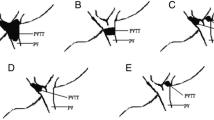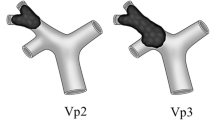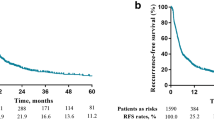Abstract
Background/purpose
We aimed to correlate the survival of patients with hepatocellular carcinoma (HCC) with macroscopic portal vein tumor thrombus (PVTT) who underwent partial hepatectomy with or without portal thrombectomy with our PVTT classification. Currently, different staging systems for HCC are widely used in clinical practice. However, they lack the refinement in giving prognosis and guiding surgical treatment once macroscopic PVTT is present.
Methods
A retrospective study was carried out, in a single tertiary center, from January 2001 to December 2004 on 441 patients who underwent partial hepatectomy with or without portal thrombectomy for HCC with macroscopic PVTT. Overall survival was examined to determine whether it was correlated with our PVTT classification, and with the TNM staging, Cancer of the Liver Italian Program (CLIP) scoring system, and the Japan Integrated Staging (JIS) scoring system.
Results
With our PVTT classification, the numbers (percentages) of patients with types I, II, III, and IV PVTT were 144 (32.7%), 189 (42.9%), 86 (19.5%), and 22 (5.0%), respectively. The corresponding 1-, 2-, and 3-year overall survival rates for types I to IV PVTT were 54.8, 33.9, and 26.7%; 36.4, 24.9, and 16.9%; 25.9, 12.9, and 3.7%; and 11.1, 0, and 0%, respectively (log-rank of the survival curves P < 0.0001). Using the TNM system, the majority of patients were classified as stage III (n = 379 or 85.9%). Similarly, the majority of patients (n = 388 or 88.0%) were classified as having CLIP scores of 2 (n = 143, or 32.4%), 3 (n = 171, or 38.8%), and 4 (n = 74, or 16.8%). The 1-, 2-, and 3-year overall survivals for these 3 CLIP scores were very similar. Using the JIS score, the majority of patients (n = 372 or 84.4%) were classified with a JIS score of 2. The 1-, 2-, and 3-year overall survivals of patients with a JIS score of 2 were worse than those of the patients with a JIS score of 1 (this was expected) as well as being worse than those with a JIS score of 3 (this was unexpected). Thus, the latter 3 systems of classification were not refined enough, and they were inadequate for stratifying HCC with macroscopic PVTT treated with partial hepatectomy with or without thrombectomy.
Conclusions
In patients with HCC with macroscopic PVTT treated by partial hepatectomy with or without thrombectomy, our PVTT classification better stratified and predicted prognosis than the TNM staging, CLIP scoring system, and JIS scoring system, which were unrefined and inadequate for this group of patients.




Similar content being viewed by others
References
Zhang JY, Dai M, Wang X, Lu WQ, Li DS, Zhang MX, et al. A case-control study of hepatitis B and C virus infection as risk factors for hepatocellular carcinoma in Henan, China. Int J Epidemiol. 1998;27:574–8.
Chung YH, Song IH, Song BC, Lee GC, Koh MS, Yoon HK, et al. Combined therapy consisting of intraarterial cisplatin infusion and systemic interferon-a for hepatocellular carcinoma patients with major portal vein thrombosis or distant metastasis. Cancer. 2000;88:1986–91.
Qiang L, Huikai L, Butt K, Wang PP, Hao X. Factors associated with disease survival after surgical resection in Chinese patients with hepatocellular carcinoma. World J Surg. 2006;30:1–7.
Wu MC, Chen H, Shen F. Surgical treatment of primary liver cancer-reported 5524 patients. Chin J Surg. 2001;39:25–8.
Yamanaka N, Okamoto E, Fujihara S, Kato T, Fujimoto J, Oriyama T, et al. Do the tumor cells for hepatocellular carcinomas dislodge into the portal venous stream during hepatic resection? Cancer. 1992;70:2263–7.
Cheng SQ, Wu MC, Chen H, Yang JH, Gong B, Cong WM, et al. The relationship between gastroesophageal varices and bleeding and portal vein tumor thrombi patients with hepatocellular carcinoma. Chin J Gen Surg. 2004;19:289–91.
Lau WY, Lai EC, Yu SC. Management of portal vein tumor thrombus. In: Lau WY, editor. Hepatocellular carcinoma. Singapore: World Scientific Publishing; 2008. p. 739–60.
Cedrone A, Rapaccini GL, Pompili M, Aliotta A, Trombino C, Deluca F, et al. Portal vein thrombosis complicating hepatocellular carcinoma: value of ultrasound-guided fine-needle biopsy of the thrombus in the therapeutic management. Liver. 1996;16:94–8.
Greene FL, Page DL, Fleming ID, Fritz AG, Balch CM, Haller DG, et al. editors. AJCC cancer staging manual. 6th ed. Chicago: Springer; 2002. p. 131–44.
Okuda K, Ohtsuki T, Obata H, Tomimatsu M, Okazaki N, Hasegawa H, et al. Natural history of hepatocellular carcinoma, prognosis in relation to treatment. Study of 850 patients. Cancer. 1985;56:918.
The Cancer of the Liver Italian Program (CLIP) Investigators. A new prognostic system for hepatocellular carcinoma: a retrospective study of 435 patients. Hepatology. 1998;28:751–5.
Kudo M, Chung H, Osaki Y. Prognostic staging system for hepatocellular carcinoma (CLIP score): its value and limitations, and a proposal for a new staging system, the Japan integrated staging score (JIS score). J Gastroenterol. 2003;38:207–15.
Llovet JM, Bru C, Bruix J. Prognosis of hepatocellular carcinoma: the BCLC staging classification. Semin Liver Dis. 1999;19:329.
Cheng SQ, Wu MC, Chen H, Shen F, Yang JH, Ding GH, et al. Tumor thrombus types influence the prognosis of hepatocellular carcinoma with the tumor thrombi in the portal vein. Hepatogastroenterology. 2007;54:499–502.
Cheng SQ, Wu MC, Chen H, Shen F, Yang JH, Cong WM, et al. A study on imagination features of tumor thrombi the portal vein of primary liver cancer. Chin J Gen Surg. 2004;19:200–1.
Cheng SQ, Wu MC, Cheng HY, Chen H. Growing features of the tumor thrombus of portal vein in hepatocellular carcinoma: report of 130 cases. Chin J Curr Adv Gen Surg. 2003;6:103–5.
Acknowledgments
This study was supported by grants of The Ministry of Science and Technology Key Program 2008ZX10002-025, National Natural Science Foundation (30873352), Shanghai Science and Technology Committee (Project No: 07JC 14066), and Shanghai Education Committee of Shuguang Plan (2005).
Author information
Authors and Affiliations
Corresponding author
About this article
Cite this article
Shi, J., Lai, E.C.H., Li, N. et al. A new classification for hepatocellular carcinoma with portal vein tumor thrombus. J Hepatobiliary Pancreat Sci 18, 74–80 (2011). https://doi.org/10.1007/s00534-010-0314-0
Published:
Issue Date:
DOI: https://doi.org/10.1007/s00534-010-0314-0




